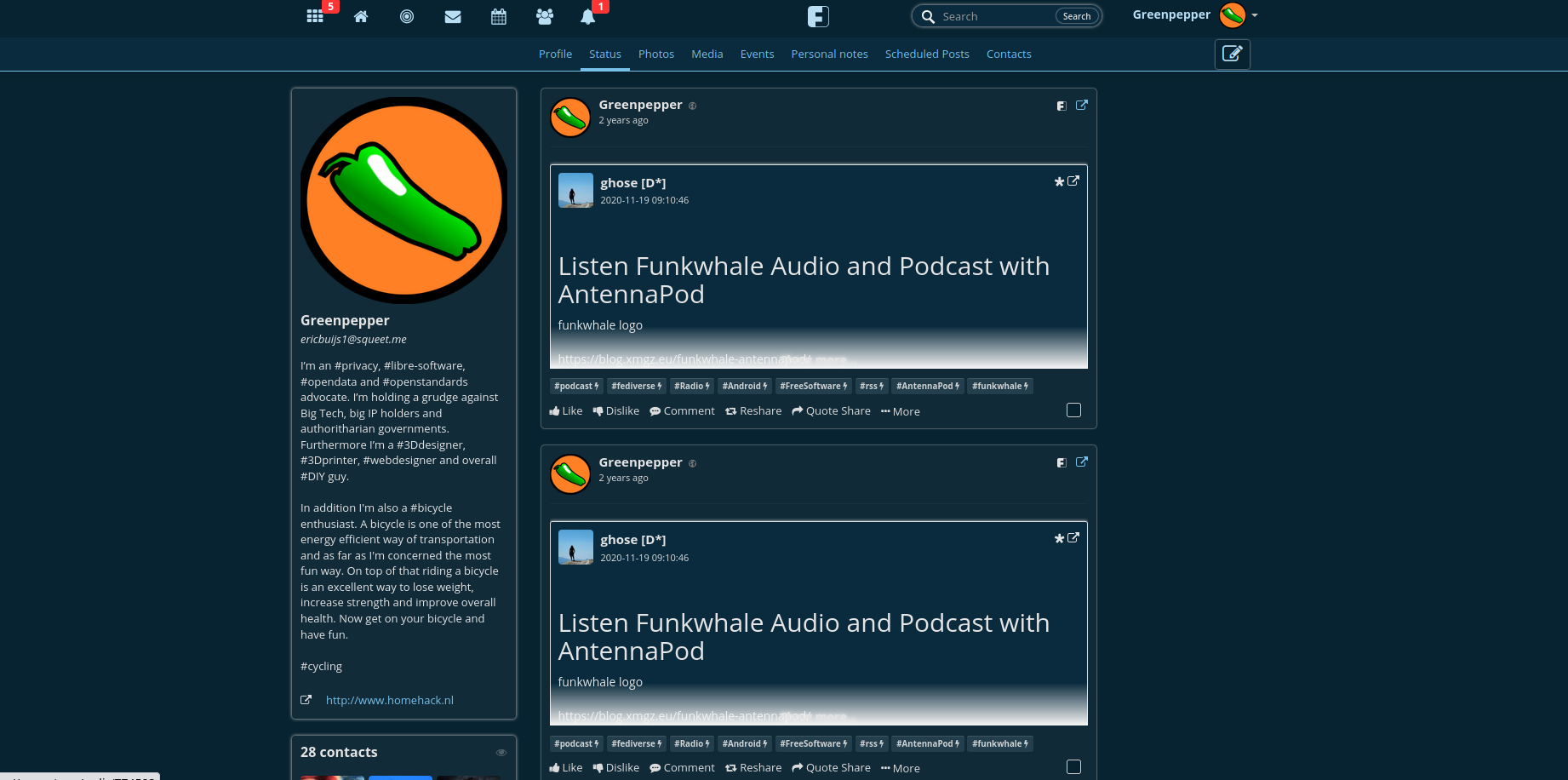
@serenity I like Friendica more than Mastodon.

@serenity
“When to use Friendica over Mastodon?”Short answer: always
Long answer: Friendica is the software of the fedeverse that allows the most complete user experience. However, thanks to the fact that Mastodon was the first successful project on activitypub and to the fact that it addressed a very specific target (Twitter users), its users have always been much more numerous than those of other software and this has meant more money and more funding which has allowed the mastodon developers to improve many aspects.
For this reason, as well as for contingent reasons (the immediacy of microblogging is an immanent feature), the comparison between Friendica and Mastodon highlights some aspects in which Mastodon is objectively superior. Between these:
- an essential and compact timeline
- universal compatibility, due simply to the fact that all other fediverse projects must adapt to mastodon if they don’t want to be cut off from the larger audience
- a modern and ergonomic graphical interface (while the Friendica one looks like the alpha version of MySpace)
- apparently faster servers: this is due to the fact that some fediverse virtualization and optimization projects are focused on mastodons; But this is also a consequence of the fact that the greater number of mastodon users allows the servers hosting the community to be financed with more donations. moreover, the increase in users of a single instance generates disruptions, slowdowns and shock waves for the entire faith universe. In fact, the disproportionate increase in mastodon users in the last three months has also led to a slowdown for smaller instances: today friendica servers are also slowed down due to the increase in mastodon users.
- mastodon has an excellent moderation system that allows you to limit the proliferation of bots, spam and scams
- mastodon is clearly aimed at an audience made up of former Twitter users; friendica on the other hand, despite being the only real alternative to Facebook, presents itself as an object without clear characterization, without a “strong message”, and aimed at a heterogeneous audience
friendica on the other hand, despite being the only real alternative to Facebook, presents itself as an object without clear characterization, without a “strong message”, and aimed at a heterogeneous audience
Yea, the fact that it was not that much cathered at being the alternative to something (in this case Facebook) really left it behind, although it is more feature complete. Hell, even diaspora has more users according to fediverse.observer. And given the development speed boost that followed the bird site takeover (which came along with the user influx), I’m afraid that Mastodon is likely to catch up and leave less room for Friendica to have a meaning for new users.
At the moment, at least, there is an influx of new users going on for quite a few months, so it definitely seems to be taking off, but it still leaves Friendica behind many other social networks, sadly.
Imo, Friendica missed some opportunities when it really had the chance of attracting new users, and given the extent of Facebook, it really could attract more users, possibly flip the balance, at least with today’s feature set. I only found recently about this whole Fediverse thing, but I was against Twitter due to the post character limit (why the hell should I have to create more than one post in order to post that seldom long idea that I have stuck in my head from time to time?), so I naturally disliked Mastodon’s model, although I like many other things at it. And over time I grew fond of its feature set. This is why I really hope Friendica will be able to take a part of the pie in the future.

@notizie @petrescatraian @serenity Friendica and Hubzilla are a bit hard to learn. These platforms need better onboarding process. The greatest advantage of Mastodon is that it is pretty familiar and doesn’t overwhelm with features.

@serenity @petrescatraian @notizie @shuro Yeah indeed. I felt the same with Friendica in the beginning but I’m a nerd so I can overcome it 😃 but I wouldn’t recommend Friendica to my friends if they aren’t IT people.

Also, the lack of support for accessibility from Friendica is a big NoNo for me. Mastodon made me learn to use CW and all-text and I can’t backtrack on a software that has less inclusivity options.
@petrescatraian @notizie @serenity Do you think there are any cases where it might be appropriate to choose #Friendica over #rebased or #Misskey?

@realcaseyrollins Really not sure, Misskey is microblogging as well, maybe? And both rebased and Misskey are newer projects, while Friendica is older and more established? Maybe you want to have a Facebook experience like in the heydays?
I want to keep the number of accounts I have to a minimum, but I might create some dummy accounts on any of these platforms to test them out.
Thanks all for the replies (I see one comment here on this instance, but twelve when I look at lemmy.ml). Nice to see more Friendica here!

@serenity It’s pretty awesome being able to interact with lemmy threads from Friendica now!

@serenity Well, I feel great that I can post and comment to Reddit with my FB account in this regard, haha ;)
I am really afraid of not doxxing myself though, haha. On the former I am more vocal usually, while on the latter I am more personal. So now I have a mix of social identities that I use for both being vocal and personal.

@serenity @petrescatraian Great to see that you can comment on Lemmy posts :) you had issues with it before, right?

@anders
I remember you had, I can’t remember, someone posted something on the Friendica support group, not sure if it was you or anyone else.Yea, I had the same issue as you. Indeed, federation between Friendica and Lemmy servers seems a bit problematic, I still search for my posts and comments on a separate Lemmy tab, unfortunately, don’t know if this is a Lemmy/Friendica issue or just related to ActivityPub, as f00fc7c8@libranet.de was saying in a previous comment. I am surprised that this comment made it through w/o such an input from my end, so wow! 😁
servers@serenity@jeremmy.ml

@petrescatraian wtf. So now I just tried again from my Venera.social profile and now it works there again as well. :D

@anders wow, speechless. I guess you never know where the problem comes from, haha.
I previously tried to force-load my initial comment to this post as well, but nothing happened, wherever I tried. 😁

@petrescatraian indeed but at least i have access to the logs now if the same or something else will happen again :D
you mean force load by searching?

@anders@rytter.me wrote:
indeed but at least i have access to the logs now if the same or something else will happen again 😁
That really is an advantage, congrats on your new server, haha! 😁
@anders@rytter.me wrote:
you mean force load by searching?
Yes

@petrescatraian and this one made it as well, right? :D
I solved the issue by spinning up my own instance :D it seems like a Libranet/Venera problem rather than a Friendica problem, because now it works fine for me.

@serenity It is possible to use content warning and alt text in Friendica posts (not very convenient but it works).
There is lack of other features though - can’t create or vote in polls, can’t upload video and audio, can’t block by domain.


Worth noting (since this isn’t mentioned anywhere in the text): Friendica is slow as fuck


@serenity @f00fc7c8 @rom It’s not even sorta fast, but I’ve found it to be the most functional for me out of the bunch. In addition to Friendica, I’ve played around with Diaspora, Mastadon, Pleroma, Misskey, plus the forks Calckey and Akkoma. Friendica’s ability to easily follow tags and rss feeds, plus the lemmy and diaspora integration, as well as the ease of import/export really shows where some of the others are lacking. That said, UI/UX customization in Friendica leaves quite a bit to be desired.






@serenity @rom @eshep @f00fc7c8 I tried to import/move my profile to my own instance but I got an error saying page not found :S did you succeed with that`?
I agree with what you say. Is your experience that Friendica is slower than the others? My guess would be that Friendica is programmed in PHP which executes slower than other programming languages.

@eshep @serenity @f00fc7c8 @rom @anders I am not sure it is about PHP but it depends how you see it.
Friendica can be rather resource-intensive, especially for public instance. Some of them feel slow because they are somewhat overloaded. On badly overloaded servers delivery times suffer.
Also mostly static interface of Friendica which I like also means most operations reload the entire page. E.g. when you go to someone’s profile it can take the same time (say 8 seconds) on Friendica and Misskey/Pleroma/Mastodon but on the latter you don’t see the page redrawn - it stays the same and something spins loading the data. On Friendica you see full page reload. It is perceived slower.
Also in some aspects Friendica is inherently slower by design. E.g. when posting comment on Mastodon it is fired off right away (well, almost), on Friendica it is queued for delivery and the worker runs on interval (usually every 2-5 mins). It isn’t a problem but feels more like email or old school forum while other platforms can feel more like instant messaging.



Did you try the recent 13.x release of Misskey? Apparently it got a massive speed improvement. Didn’t try it myself yet though and also don’t really have fresh memory to compare it against.

@poVoq not yet, my experience is mostly with Calckey

Then maybe I wasn’t very lucky with my instance choice (libranet.de), because jfc, doing anything, from sharing a post to simply browsing the timeline, was a chore

@serenity@jeremmy.ml wrote:
* No option for a content warning in a post you’re creating. This option is heavily used in Mastodon e.g to warn people for a post about a sensitive topic e.g politics. Friendica does respect content warnings from Mastodon though.
* No option to add a text to an image. Mastodon has this option to include visually impaired people.
* No option to blur an image. In Mastodon this is a feature similar to a content warning for a text.Have you tried BBCodes? while in your node press on your profile name in the top-right corner of your screen (if you’re using the Frio theme) > Help > BBCode tag reference to see what you can do. They can do everything you said.

Of all the markup languages in the world, why BBCode??

@sxan @petrescatraian It seemed like a good idea in 2010 for a PHP app with a forum-like feature.

Yeah, I get the origins. I wish there’d be a mime-type update to move it into modern times.
The irony is that they got it right in the 80’s. Simple markup conventions forced by pre-mime text/plain emails and, later in the 90’s, SMS are still the basis for most lightweight markup languages.

@petrescatraian @sxan What’s wrong with BBCode? It is simpler to learn for non-technical folks.

Is it? Really? Easier for non-technical users than Markdown?
Most simple markup languages (djot, markdown, asciidoc, textile, etc.) are based on 7-bit ASCII markup that people have been using in email and SMS for decades. They’re compact and straightforward. BBCode is a bastardization (I use that in its technical sense more than as a pejorative) of HTML; it’s verbose and unintuitive.
Give a non-technical person with no other information a keyboard and a plain text field and ask them to emphasize a word in some text. I’ll bet the first thing they do is all caps. If you ask them to do it without caps, I bet you’ll get something like surrounding the text in asterisks or hashmarks, but regardless, what you won’t get is bracket-B-bracket followed by a closing tag.
BBCode is just straight-up HTML for people allergic to pointy characters. That’s hardly non-technical.

@sxan I have different opinion on this but I am not UX specialist.
Surely to just highlight something it is easier to use underscore or similar characters but when you want to have variety of formatting styles in my opinon text tags are easier to remember and use. Yes, more to type but BBCode-enabled solutions usually provide some sort of assist.
Also Markdown tends to conflict with user input more often which is confusing.

I think it comes down to: when we’re dealing with truly non-technical users, we hope the clients have some sort of UI to insert codes; very non-tech users aren’t going to be very handy with any markup, and the best thing for them is some sort of WYSIWYG interface, or at very least an “insert markup buttons” feature.
For the people writing markup by hand, IMO markup that minimally interferes with reading when it is unline (unrendered) is best. HTML, BBCode, and other heavy markup gets in the way more than (e.g.) djot, asciidoc, markdown, and other languages that descend from intuitively evolved markup from 70’s email systems.
Vivat diversitas.

Thanks for the info about BBCode. I didn’t know about this option before. However I can’t figure out how to implement some of it. I was testing out alt text and am pretty sure I was formatting the BBCode properly. Once I created the post, it would display the image but I could never figure out how to view the alt text. Do you know how to implement it?

@petrescatraian @Samlane86 Did you have a go at the spoiler tag?
[spoiler=Reveal Text]spoiled text[/spoiler]<details class=“spoiler”><summary>Reveal Text</summary>spoiled text</details>

@Samlane86 Guess it shows up when the image does not load properly. Or when you hover your cursor over the image. Usually if you type should work just fine. That’s what I do at least.
Edit: here’s an example:
Also use the preview pane/button before posting a comment, so you can make adjustments if something goes wrong. In my experience, lists do not work properly unless you use
*to make lists, as Friendica does support markdown as well. However, it turns markdown into bbcode, so if I have to edit a comment with a list, I have to switch back to Markdown formatting there.
Correction: I just tried again and viewed the post on Mastodon. The alt text does appear there, so the code does work. Just not when viewed on Friendica. Am I just looking in the wrong places? Or does it just not display natively?
- jay91 ( @jay91@lemmy.ml ) 2•1 year ago
Can this be used for social news sharing, like lemmy?

@jay91 You can create forums, which are, practically, like fb groups. In fact, Lemmy communities appear as forums as well. Hell, you can even set your account as a news organization:
imgur.com/7wVSTRe.png

@serenity Never heard about Epicyon…

IMO Friendica feels like beta software or outdated with no signs of improvement. Similar to how LibreOffice used to be for years. The layout is just not streamlined enough. It’s unnecessary complicated and the UI looks outdated on all themes.


